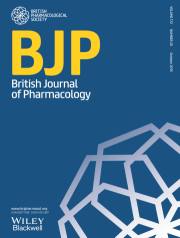British Journal of Pharmacology
 | |
| Discipline | Pharmacology |
|---|---|
| Language | English |
| Edited by | Péter Ferdinandy |
| Publication details | |
Former name(s) | British Journal of Pharmacology and Chemotherapy |
| History | 1946–present |
| Publisher | Wiley-Blackwell on behalf of the British Pharmacological Society (United Kingdom) |
| Frequency | Bi-monthly |
| Delayed (after 12 months) | |
| 6.8 (2023) | |
| Standard abbreviations | |
| ISO 4 | Br. J. Pharmacol. |
| Indexing | |
| CODEN | BJPCBM |
| ISSN | 0007-1188 (print) 1476-5381 (web) |
| LCCN | 2005204900 |
| OCLC no. | 01240522 |
| Links | |
The British Journal of Pharmacology is a biweekly peer-reviewed medical journal covering all aspects of experimental pharmacology. It is published for the British Pharmacological Society by Wiley-Blackwell. It was established in 1946 as the British Journal of Pharmacology and Chemotherapy, and originally published by the British Medical Association. The journal obtained its current title in 1968.[1]
The current editor-in-chief is Péter Ferdinandy.[2] Previous editors-in-chief include Amrita Ahluwalia, Ian McGrath, Humphrey Rang, Alan North, Phil Moore, Bill Large, and Tony Birmingham. A sister journal, also published for the British Pharmacological Society by Wiley-Blackwell is the British Journal of Clinical Pharmacology. The journal publishes research papers, review articles, commentaries and correspondence in all fields of pharmacology. It also publishes themed issues, as well as supplements.
The Concise Guide to PHARMACOLOGY
[edit]The Concise Guide to PHARMACOLOGY is a supplement of the British Journal of Pharmacology, replacing the "Guide to Receptors and Channels". It is produced in association with the Nomenclature Committee of the International Union of Basic and Clinical Pharmacology. The current version, The Concise Guide to PHARMACOLOGY 2019/2020, was published in December 2019, and edited by Stephen Alexander, Eamonn Kelly, Alistair Mathie, John Peters and Emma Veale. This edition is a compilation of the major pharmacological targets divided into seven sections: G protein-coupled receptors, ion channels, catalytic receptors, nuclear receptors, transporters, and enzymes. These are presented with nomenclature guidance and summary information on the best available pharmacological tools, alongside suggestions for further reading. It is freely available online and also available in hard copy. Previous editions of the "Guide to Receptors and Channels" are available through PubMed Central. The content of the "Concise Guide to PHARMACOLOGY" is also available through the online portal Guide to PHARMACOLOGY.
Abstracting and indexing
[edit]The journal is abstracted and indexed in:
- Academic OneFile[3]
- Academic Search[3]
- BIOSIS Previews[4]
- CAB Abstracts[5]
- Chemical Abstracts[6]
- Chimica[3]
- CINAHL[7]
- Current Contents/Life Sciences[4]
- Elsevier BIOBASE[3]
- Embase[3]
- Global Health[8]
- Index Medicus/MEDLINE/PubMed[9]
- Science Citation Index Expanded[4]
- Scopus[3]
- Tropical Diseases Bulletin[10]
According to the Journal Citation Reports, the journal has a 2023 impact factor of 6.8.[11]
References
[edit]- ^ Cuthbert, Alan W (2009-02-02). "A brief history of the British Pharmacological Society: A brief history of the BPS". British Journal of Pharmacology. 147 (S1): S2 – S8. doi:10.1038/sj.bjp.0706496. PMC 1760755. PMID 16402105.
- ^ "BPS Publications". British Pharmacological Society | Journals. Retrieved 2021-12-06.
- ^ a b c d e f "British Journal of Pharmacology". Ulrichsweb. Retrieved 2014-12-18.
- ^ a b c "Master Journal List". Intellectual Property & Science. Thomson Reuters. Archived from the original on 2017-09-26. Retrieved 2014-12-27.
- ^ "Serials cited". CAB Abstracts. CABI. Retrieved 2014-12-27.
- ^ "CAS Source Index". Chemical Abstracts Service. American Chemical Society. Archived from the original on 2010-03-10. Retrieved 2014-12-27.
- ^ "CINAHL Complete Database Coverage List". CINAHL. EBSCO Information Services. Retrieved 2014-12-27.
- ^ "Serials cited". Global Health. CABI. Retrieved 2014-12-27.
- ^ "British Journal of Pharmacology". NLM Catalog. National Center for Biotechnology Information. Retrieved 2014-12-27.
- ^ "Serials cited". Tropical Diseases Bulletin. CABI. Retrieved 2014-12-27.
- ^ "British Journal of Pharmacology". 2023 Journal Citation Reports (Science ed.). Clarivate. 2024 – via Web of Science.
